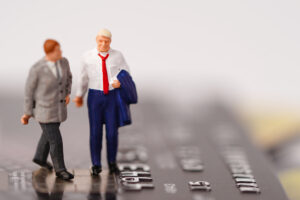Should you buy Nvidia shares in Australia?
![]() Nick Sundich, August 29, 2024
Nick Sundich, August 29, 2024
Many investors are likely wondering if they should buy Nvidia shares in Australia? Others still might be wondering just who this company is and whether it really deserves to be one of the top stocks across the globe, trailing Apple and Microsoft by market capitalisation as of late August 2024. In fat, it is worth roughly the same as the next 10 biggest chipmakers combined.
Whether or not NVDA deserves its place, it is one of the Magnificent Seven stocks and is worth over US$3tn. It is what it is. And consequently, it is worth knowing about as much as its peers.

Nvidia (NDQ:NVDA) share price chart, log scale (Source: TradingView)
Who is Nividia? AI Pioneers
According to the company’s Investor Relations department,’ NVIDIA is the pioneer of GPU-accelerated computing’. GPU is short for graphics processing units and these are computer chips in their own right as well as chip components. These are designed to handle and accelerate graphics workloads and display graphics content to the extent that Central Processing Units (CPUs) could not at the time. This enabled the growth of PC gaming market.
These days, GPUs are behind modern AI, because they act as the ‘brain’ of computers, robots and self-driving cars. In other words, GPUs help them operate by ensuring they can comprehend real-world inputs.
Intel is actually a larger maker of graphic chips than NVDA because most of its CPUs ship with the company’s own integrated graphics silicon. But this goes to show that NVDA’s GPUs are very important to the world. Another client is OpenAI, which is behind Chat-GPT technology.
Most investors will know what Chat-GPT is, but they won’t know that GPT-4 has over 1 trillion parameters. Clearly, very strong supporting technology will be needed. Yet this is not the only use of GPUs, others include (but are not limited to) in cryptocurrency, semiconductors manufacturing, pharmaceuticals, the metaverse and electric vehicles.
Granted, some of these technologies are at early stages, but since NVDA has such a foothold in many of these markets, there is huge opportunity ahead. And given the company has grown its revenues just about every single year, there is confidence this will continue. If you don’t want to take its revenues or share price growth as a sign of investor excitement – ask yourself how many other companies’ most passionate investors have ‘watch parties’ for their quarterly results.
Nvidia's $NVDA Q2 Revenue and Net Income every Q2 since going public
Revenue:
1999: $78M
2000: $170M
2001: $260M
2002: $427M
2003: $460M
2004: $456B
2005: $575M
2006: $688M
2007: $935M
2008: $893M
2009: $777M
2010: $811M
2011: $1B
2012: $1B
2013: $977M
2014: $1.1B
2015: $1.2B… pic.twitter.com/hl7wWqlMd0— Evan (@StockMKTNewz) August 28, 2024
Just how much is it tipped to grow?
Nvidia is covered by nearly 50 analysts on Wall Street and the average target price is US$1,078.62, up 14% from its current levels. It uses a February to January financial year and analysts expect revenues to more than double over the next year from $60.9bn in FY24 to $116.1bn in FY25. Then to $147.5bn in FY26, $173.5bn in FY27, then $213.8bn in FY28…hopefully you get the picture.
Turning to its bottom line, it made a $29.9bn profit (or $11.93 per diluted share), representing a profit margin of nearly 50% huge increase from the $4.4bn the year before. In FY25, analysts expect $65.1bn, followed by $78.3bn in FY26, $93.2bn in FY27 and $126bn in FY28.
Nvidia may seem expensive, but it really isn’t
Like many tech stocks though, it is far from a clear course. NVDA’s share price does have some flat days, or even some days of decline – including at some of its quarterly results. US government restrictions on the export to chips to China are a short-term headwind. It is trading at a P/E of ~37.4x for FY25, a figure well ahead of the S&P500’s ~20x P/E, although few other stocks have such growth potential.
We observe that it is trading at a PEG of just 1.1x while many of its peers trade at 2-3x. Meanwhile, the average P/E of the other Magnificent Seven is 36.2x and only Alphabet and Apple are lower than NVDA. And despite having a market cap of US$2.8tn, it does trail a couple of other companies including Microsoft (capped at $3.2tn) and Apple ($2.9tn). Both of those names are industry behemoths, but are growing nowhere near what Nvidia is. Could Nvidia catch up in the near future? Of course, it could.
And so, should you buy Nvidia shares in Australia?
Ultimately, that is a question investors will have to answer for themselves. In our view, dividend investors should not, because although the company pays dividends, they are not that high (i.e. US$0.01 per quarter which is a yield of less than 0.1% at the current share price). It is likely to remain this way for a while. Investors uncomfortable with short-term fluctuations shouldn’t either – these can happen at each and every quarterly result.
But as for investors with a long-term horizon, it will be difficult to go wrong with this one, unless things go terribly off the rails at the company, or in regard to the broader AI revolution, or in China.
What are the Best ASX Technology Stocks to invest in right now?
Check our buy/sell tips
Blog Categories
Get Our Top 5 ASX Stocks for FY25
Recent Posts
Some ASX stocks could be hit by Trump Tariffs: Here are 6 in the Firing Line!
Trump Tariffs: They’re back with a vengeance and even worse than last time. During the first Trump administration, tariffs were…
Ramelius Resources (ASX:RMS): A $3bn gold miner, trading at a very cheap P/E
Ramelius Resources‘ (ASX:RMS) $3bn market cap may suggest it is expensive, but its P/E (7x for FY25 and 10.9x for…
Help: I own a delisted ASX company! What can I do?
If you own shares in a delisted ASX company, you’re probably wondering what to do. Some stocks have a happy…



